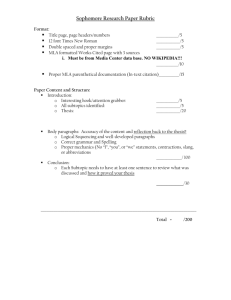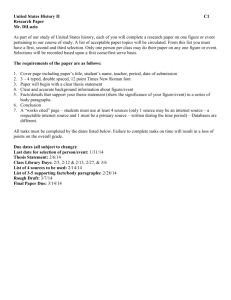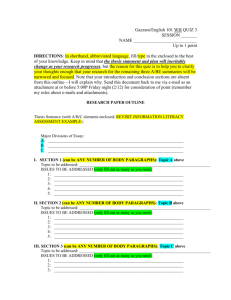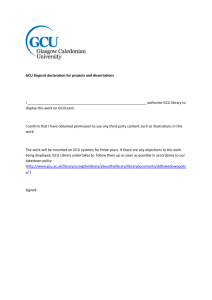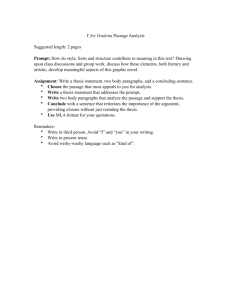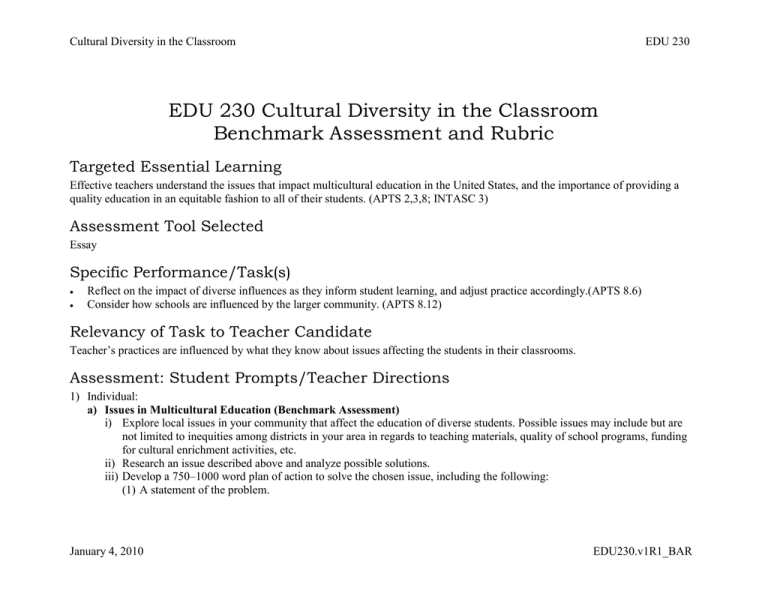
Cultural Diversity in the Classroom
EDU 230
EDU 230 Cultural Diversity in the Classroom
Benchmark Assessment and Rubric
Targeted Essential Learning
Effective teachers understand the issues that impact multicultural education in the United States, and the importance of providing a
quality education in an equitable fashion to all of their students. (APTS 2,3,8; INTASC 3)
Assessment Tool Selected
Essay
Specific Performance/Task(s)
Reflect on the impact of diverse influences as they inform student learning, and adjust practice accordingly.(APTS 8.6)
Consider how schools are influenced by the larger community. (APTS 8.12)
Relevancy of Task to Teacher Candidate
Teacher’s practices are influenced by what they know about issues affecting the students in their classrooms.
Assessment: Student Prompts/Teacher Directions
1) Individual:
a) Issues in Multicultural Education (Benchmark Assessment)
i) Explore local issues in your community that affect the education of diverse students. Possible issues may include but are
not limited to inequities among districts in your area in regards to teaching materials, quality of school programs, funding
for cultural enrichment activities, etc.
ii) Research an issue described above and analyze possible solutions.
iii) Develop a 750–1000 word plan of action to solve the chosen issue, including the following:
(1) A statement of the problem.
January 4, 2010
EDU230.v1R1_BAR
Cultural Diversity in the Classroom
EDU 230
(2) Who is involved:
(a) As part of the problem?
(b) As part of the solution?
(3) What is the proposed solution?
(4) What will be needed to implement the solution (e.g., money, time, manpower, materials, etc.)?
(5) What is the projected timeline to implement the solution?
(6) What is the expected outcome?
iv) Use the GCU eLibrary to research a minimum of three to five peer-reviewed articles that can be used in support of your
content.
v) Prepare this assignment according to the guidelines found in the GCU Style Guide, located in the Student Success Center.
vi) Submit the assignment to the instructor by the end of Module 6.
vii) Additionally, submit the assignment in TaskStream. Directions for submitting to TaskStream can be found on the College
of Education’s page in the Student Success Center.
Scoring Tool/Guide (Rubric)
Issues in Multicultural Education
Criteria
%
Value
% Scaling
1: Unsatisfactory
2: Less Than
Satisfactory
3: Satisfactory
4: Good
5: Excellent
0%
65%
75%
85%
100%
Content – 80%
Plan of Action
ACEI 3.2, 5.2
NCSS Themes 1.1,
1.3, 1.4, and 1.5
NMSA 6
January 4, 2010
60%
Prompts are not included.
They are not thoughtful,
complete, and reflective.
Few prompts are
included. They are not
thoughtful and
complete.
Most prompts are included.
They are somewhat
thoughtful and complete.
All prompts are
included. They are
thoughtful and
complete.
All prompts are
included.
They are thoughtful,
complete, and
persuasive.
EDU230.v1R1_BAR
Cultural Diversity in the Classroom
Analysis of Process
20%
EDU 230
Submission does not
include an analysis.
ACEI 3.2, 5.2
NMSA 6
Analysis is somewhat
reflective and does not
include beliefs or
biases.
Analysis is somewhat
reflective and includes
beliefs and biases.
Analysis is reflective
and includes beliefs
and biases.
Analysis is clear,
persuasive, and
reflective; it includes
beliefs and biases.
Thesis and/or main
claim is clear,
forecasting
development of
paper. It is
descriptive and
reflective of the
arguments and
appropriate to the
purpose.
A logical progression
of ideas between
paragraphs is
apparent. Paragraphs
exhibit a unity,
coherence, and
cohesiveness. Topic
sentences and
concluding remarks
are as appropriate to
purpose.
Prose is largely free
of mechanical errors,
although a few may
be present. Uses a
variety of sentence
structures and
effective figures of
speech.
Thesis and/or main
claim is comprehensive;
contained within the
thesis is the essence of
the paper. Thesis
statement makes the
purpose of the paper
clear.
Organization and Effectiveness – 17%
Thesis Development
and Purpose
6%
Paper lacks any
discernible overall
purpose or organizing
claim.
Thesis and/or main
claim is insufficiently
developed and/or
vague; purpose is not
clear.
Thesis and/or main claim is
apparent and appropriate to
purpose.
Paragraph
Development and
Transitions
6%
Paragraphs and transitions
consistently lack unity
and coherence. No
apparent connections
between paragraphs.
Transitions are
inappropriate to purpose
and scope. Organization
is disjointed.
Some paragraphs and
transitions may lack
logical progression of
ideas, unity, coherence,
and/or cohesiveness.
Some degree of
organization is evident.
Paragraphs are generally
competent, but ideas may
show some inconsistency in
organization and/or in their
relationships to each other
5%
Surface errors are
pervasive enough that
they impede
communication of
meaning. Inappropriate
word choice and/or
sentence construction.
Frequent and repetitive
mechanical errors
distract the reader.
Inconsistencies in
language choice
(register), sentence
structure, and/or word
choice are present.
Some mechanical errors or
typos are present, but are
not overly distracting to the
reader. Correct sentence
structure and audienceappropriate language.
Mechanics of Writing
(includes spelling,
punctuation,
grammar, language
use)
January 4, 2010
There is a sophisticated
construction of
paragraphs and
transitions. Ideas
progress and relate to
each other. Paragraph
and transition
construction guide the
reader. Paragraph
structure is seamless.
Writer is clearly in
command of standard,
written academic
English.
EDU230.v1R1_BAR
Cultural Diversity in the Classroom
EDU 230
Format -3%
Paper Format
(1” Margins
12 point-font
Double Spaced
Times New Roman,
Arial, or Courier)
Research Citations
(In-text citations for
paraphrasing and
direct quotes,
reference page listing
and formatting; (as
appropriate to
assignment)
1%
GCU Template is not
used appropriately or
documentation format is
rarely followed correctly.
GCU Template is used,
but some elements are
missing or mistaken;
lack of control with
formatting is apparent.
GCU Template is used;
Formatting is correct,
although some minor errors
may be present.
GCU Template is
fully used; There are
virtually no errors in
formatting style.
All format elements are
correct.
2%
No reference page; no
citations.
Reference page is
present; Citation is
inconsistently used.
Reference page is included
which lists sources used in
paper; Sources are
appropriately documented,
although some errors may
be present
Reference page is
present and fully
inclusive of all cited
sources;
Documentation is
appropriate and GCU
style is usually
correct.
In-text citations and a
Reference page are
complete. The
documentation of cited
sources is error-free.
© 2010. Grand Canyon University. All Rights Reserved.
January 4, 2010
EDU230.v1R1_BAR

